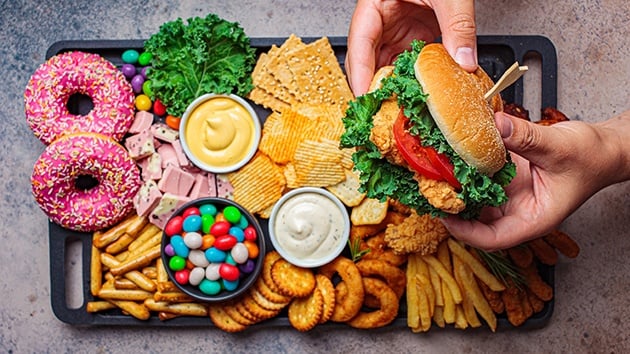In 2022, the *American Journal of Clinical Nutrition* published a survey-based study on 40,937 individuals, focusing on changes in eating habits among adults from 2001 to 2018. The results indicated a significant year-over-year increase in the percentage of calories derived from ultra-processed foods. By 2018, 57% of consumers’ total calorie intake came from these food sources. This highlights a growing trend of people consuming large quantities of ready-to-eat processed foods without fully realizing the potential negative health implications.
Dr. Wei Shihang from Churi Clinic in Taiwan has shed light on the issues surrounding “ultra-processed foods,” underscoring their detrimental health effects.
Definition of Ultra-Processed Foods
According to the Nova Food Classification System, developed by the University of Sao Paulo, Brazil, in 2009, foods and beverages are categorized into four groups based on their nature, extent, and purpose of processing:
Level 1: Unprocessed or minimally processed foods, including fruits, vegetables, legumes, fish, eggs, and meat. These foods contain no additives and can be prepared through methods like cutting, heating, grinding, drying, or freezing.
Level 2: Processed culinary ingredients derived from refining and grinding Level 1 foods, such as butter, flour, salt, and soy sauce.
Level 3: Processed foods produced using ingredients from Levels 1 and 2, along with additives to prevent spoilage.
Level 4: Ultra-processed foods are industrially manufactured products that utilize multiple additives and non-natural ingredients. This includes sugary drinks, packaged snacks, frozen meals, and ready-to-eat dishes that can be quickly prepared in a microwave. They tend to be high in fat, sugar, and salt to enhance flavor and extend shelf life.

Ultra-processed foods are industrially manufactured with many additives and non-natural ingredients.
Negative Impacts of Ultra-Processed Foods
Dr. Kevin Hall, a leading obesity expert and researcher at the National Institute of Health in the United States, conducted an intriguing study on ready-to-eat processed foods. He selected 20 weight-stable adults and divided them into two groups: one consuming ultra-processed foods and the other consuming unprocessed foods.
Both groups were provided with meals containing identical nutritional profiles and total calorie counts, while participants were allowed to decide how much they wanted to eat. Interestingly, the group consuming ultra-processed foods averaged 500 more calories per day than the other group, resulting in an average weight gain of 0.9 kg. This may be attributed to the stimulation of ghrelin (the hunger hormone) and the suppression of leptin (the satiety hormone) by ultra-processed foods, leading to a lack of awareness of overconsumption in terms of both quantity and calories.
Recent research has linked excessive consumption of ultra-processed foods to a heightened risk of 32 health conditions, including cardiovascular diseases, type 2 diabetes, and cancer, and even early death. Specifically, these foods are associated with a 50% increased risk of mortality from cardiovascular disease and a 48-53% higher likelihood of anxiety and psychiatric issues. Additionally, they contribute to a nearly 50% heightened risk of obesity, type 2 diabetes, insomnia, and other health problems.
Commenting on the study, researchers noted, “Overall, the authors found that consuming large amounts of ultra-processed foods may harm nearly all bodily systems.”

Consuming large amounts of ultra-processed foods can be detrimental to almost all bodily systems.
Why Are Ultra-Processed Foods Still Popular Despite Their Harmful Effects?
Euphoric Sensation
Ultra-processed foods are meticulously designed by food manufacturers and scientists through extensive testing and mathematical models to balance ingredients like sugar, fat, salt, and additives. The goal is to optimize flavor and create addictive products. The ratio of these components strongly stimulates the brain’s reward mechanism, triggering dopamine release and inducing a pleasurable response, ultimately leading to a form of “addiction.”
Furthermore, the speed of signal transmission in the body related to ultra-processed foods is exceptionally fast. Research has shown that the faster the signal transmission, the higher the potential for addiction.
Convenience and Affordability
Ultra-processed foods stand out for their convenience, being easier to access and prepare than unprocessed foods. The addition of preservatives and other additives extends their shelf life, making them more transportable and displayable in stores. This contributes to their lower cost and wider accessibility.
Aggressive marketing and advertising campaigns by manufacturers have also played a role in shaping modern eating habits, such as consuming popcorn and soda at the movies or giving chocolates on Valentine’s Day.

Ultra-processed foods offer convenience and are often more affordable.
Effective Ways to Eliminate Ultra-Processed Foods
Alter Your Environment and Shopping Habits
Instead of relying on large supermarkets or convenience stores for daily groceries, opt for specialty shops that sell fresh meat, fruits, and vegetables. These places often offer healthier options, reducing the temptation to buy processed foods. Creating a shopping list beforehand is also crucial; buying only what you need can help you avoid unhealthy choices.
Pay Attention to Labels
When selecting processed foods, read the labels carefully. Even when choosing potato chips, for instance, opt for the plain variety with minimal additives. Additionally, be cautious of products marketed as “healthy,” such as oat milk or plant-based milk alternatives, as they often contain high amounts of sugar or inflammatory vegetable oils.































